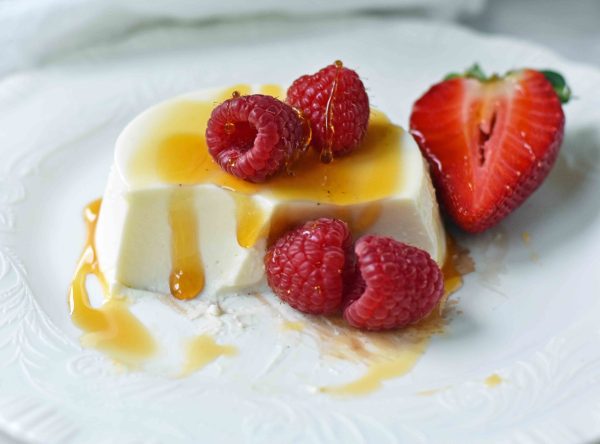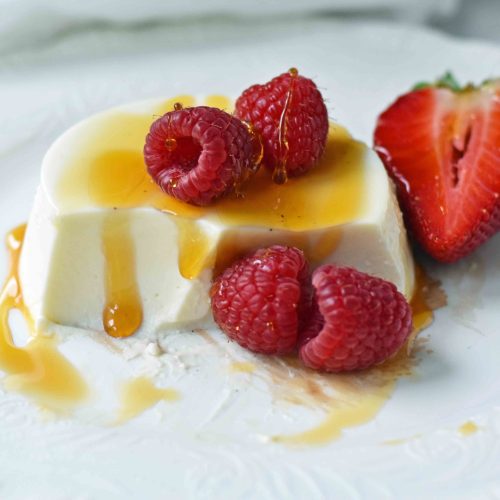
Panna Cotta Recipe
The traditional panna cotta recipe, which translates to “cooked cream” in Italian, has its roots in the country’s north. This smooth dessert’s taste, simplicity, and elegance have made it popular all over the world. Everything you need to make the ideal panna cotta at home will be covered in this article, including its history, ingredients, preparation time, serving sizes, calorie count, tools, and detailed instructions. To guarantee that your panna cotta turns out perfectly, we’ll also offer some suggestions for related recipes and answer commonly asked questions.
Panna Cotta’s history:
It is thought that the Italian region of Piedmont is where the invention of panna cotta occurred in the early 1900s. Traditionally, to make the dish, cream, milk, and sugar were simmered before being combined with gelatin to set. Over time, panna cotta has evolved to include various flavors and toppings, making it a versatile and beloved dessert in Italian cuisine and beyond.

Panna Cotta Recipe
Equipment
- Small saucepan
- Whisk
- Mixing bowl
- Measuring cups and spoons
- Ramekins or small dessert cups
- Plastic wrap
Ingredients
- 2 cups (500 ml) heavy cream
- 1 cup (250 ml) whole milk
- 1/2 cup (100 g) granulated sugar
- 1 vanilla bean (or 1 teaspoon vanilla extract)
- 2 1/2 teaspoons unflavored gelatin powder
- 3 tablespoons cold water
Instructions
- Prepare the Gelatin:In a small mixing bowl, sprinkle the gelatin powder over the cold water. Let it sit for 5-10 minutes to bloom.
- Heat the Cream Mixture:In a small saucepan, combine the heavy cream, whole milk, and granulated sugar. If using a vanilla bean, split it lengthwise, scrape out the seeds, and add both the seeds and the bean to the saucepan. If using vanilla extract, add it later.
- Dissolve the Sugar:Heat the cream mixture over medium heat, stirring occasionally until the sugar is completely dissolved. Do not let the mixture boil.
- Add the Gelatin:Remove the saucepan from the heat. Add the bloomed gelatin to the hot cream mixture and whisk until the gelatin is fully dissolved. If using vanilla extract, add it now.
- Strain the Mixture:For an extra smooth texture, strain the mixture through a fine-mesh sieve into a large measuring cup or a bowl. This step is optional but recommended.
- Pour into Molds:Evenly pour the panna cotta mixture into ramekins or small dessert cups. Allow them to cool to room temperature.
- Chill the Panna Cotta:Cover each ramekin with plastic wrap and refrigerate for at least 4 hours or until set. Overnight chilling is even better.
- To serve, you can unmold the panna cotta by running a knife around the edges and inverting it onto a plate. Alternatively, serve it directly in the ramekins.
Video
Similar Recipes:
Crème Brûlée: Another creamy dessert with a caramelized sugar topping.
Flan: A creamy custard dessert with a caramel sauce.
Mousse: a light and airy dessert, often made with chocolate or fruit.
Tiramisu: a coffee-flavored Italian dessert with layers of mascarpone and ladyfingers.
Frequently Asked Questions About Panna Cotta Recipe:
1. What ingredients do I need for panna cotta?
The ingredients for panna cotta, an Italian dessert with a silky, smooth texture, are cream, milk, sugar, and gelatin.
2. Does gelatin have a place in panna cotta recipe?
Agar-agar can be used in place of meat, but the texture might alter slightly.
3. How much time is needed for the panna cotta to set?
In the refrigerator, it usually takes at least 4 hours to set, but for a firmer texture, overnight is ideal.
4. Can I make panna cotta using non-dairy milk?
Sure, you can use almond milk, coconut milk, or other nondairy substitutes, but the flavor and texture may change.
5. How should panna cotta be stored?
Cover the panna cotta with plastic wrap and refrigerate for up to three days.
6. Can panna cotta be frozen?
Freezing can change the texture and cause it to become gritty, so it is not advised.
7. What seasonings work well for panna cotta?
You can add other flavors, such as chocolate, coffee, vanilla, or even zest from citrus fruits. You can even add herbs, like basil or rosemary, to the cream.
8. What kinds of toppings complement panna cotta?
Nuts, caramel sauce, chocolate shavings, fresh berries, and fruit coulis are all excellent choices.
Conclusion:
Panna cotta is a delightful dessert that’s surprisingly easy to make at home. With its rich, creamy texture and endless possibilities for toppings and flavors, it’s sure to impress your family and friends. Try this classic recipe and enjoy a taste of Italy in your own kitchen!
YouTube Video Credits:
The Cooking Foodie

Leave a Reply